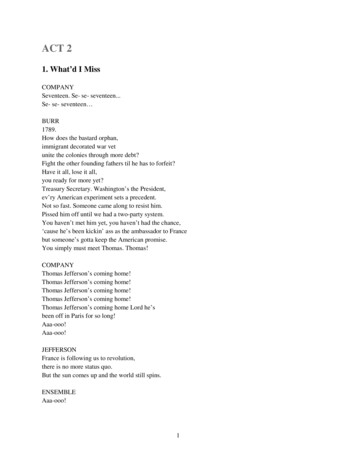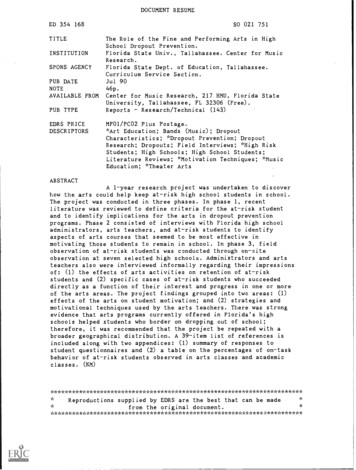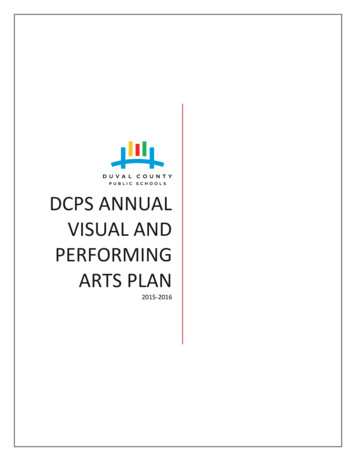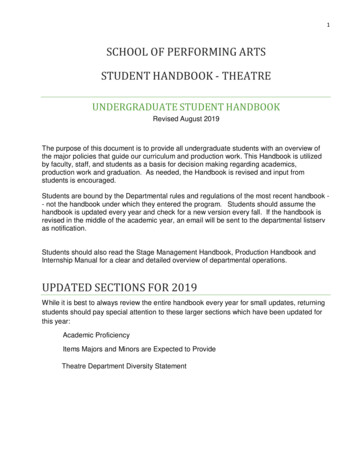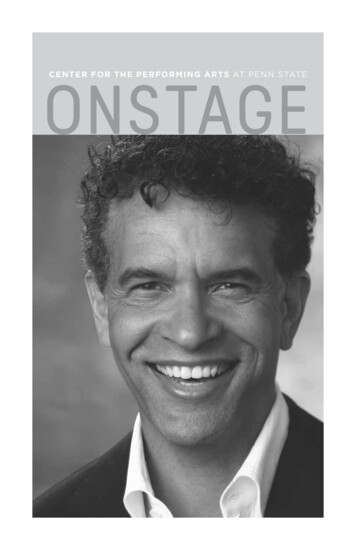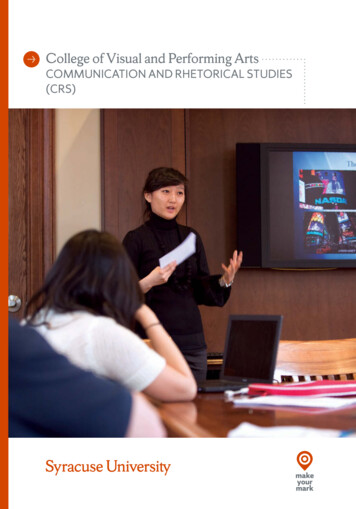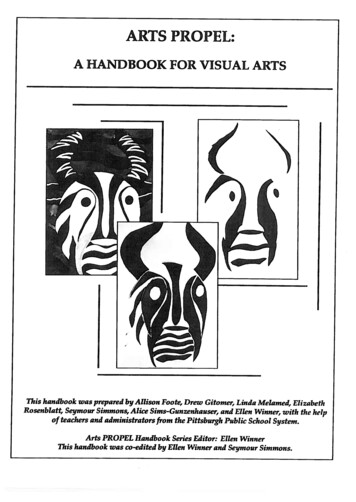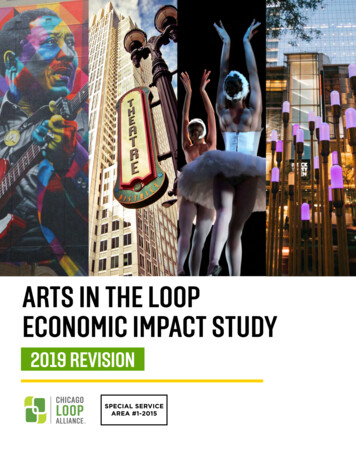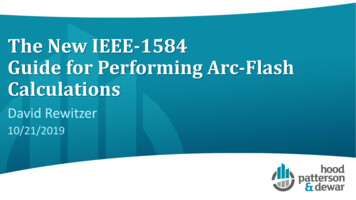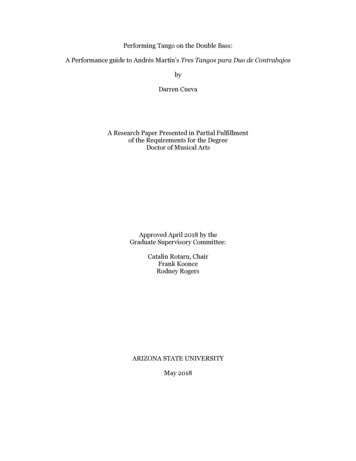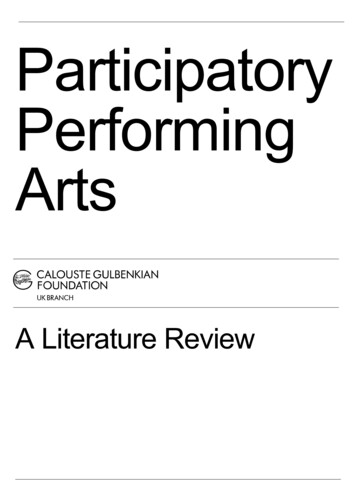
Transcription
ParticipatoryPerformingArtsA Literature Review
12Chrissie Tiller Associates September 2014 for the Calouste Gulbenkian FoundationThe TeamLiterature Review Writer/Editor: Chrissie TillerSenior Researchers: Nela Milic, David Linton, Sireita MullingsJunior Researcher and Case Studies: Lucy WarrenPARTICIPATORY PERFORMING ARTS: A Literature Review1
12ContentsIntroduction 3One: Engaging with the debate .7Two: Reviewing the evidence .31Conclusion . 57Bibliography 60PARTICIPATORY PERFORMING ARTS: A Literature Review2
12Introduction‘You can’t tick a box called profundity’Alan Davey, Chief Executive Arts Council 20141‘Everyone likes art. We just don’t all like the same art.’ 2 If we concur with Matarasso that we allthink about art differently, how can we agree on the value of the art we see, experience, own, pursue,want to develop, invest in or educate about: especially when trying to capture the aesthetic andcognitive dimensions of our experience? How, as artists and arts organisations, do we bestevidence the impact of our own projects and programmes in a way that reflects on-goingconversations about the value of culture?One of the biggest challenges for those working in performing arts is finding ways of collecting datathat reflect the value and impact of engaging with live performance rather than what culturaleconomists such as Klamer (2004), and those who follow him, speak of as ‘cultural goods3’: the‘worth’ of objects being measured in the context of production. Cultural value, in these terms, oftenbecoming something where notions of an object’s quality, nature, content and form shift inaccordance with the contemporary environment and its reception, circulation and consumption, aswell as on the preservation of assets, practices, knowledge or sites through which it can be recreatedin the future. Like the Prado Museum taking responsibility beyond custodianship, to use itsreputation and brand to mark work that was once in the public domain as now exclusive and only tobe accessed by a certain elite.It is a way of thinking about value that leads to small scale, minority, emergent practices, many ofwhich contribute to the sustenance of culture by fostering change, edginess and creativity, beingside-lined for those whose monetary worth is easier to prove. Geoffrey Crossick, (Director ofAHRC’s Cultural Value project) suggests in a recent interview, ‘I don't know anybody in the arts whodoes it directly to have an economic impact.’4 Yet it is those working at the coalface who increasinglyfind themselves adjusting and reducing projects to prise them into frameworks that end upreflecting neither the ethos and values of the artists and organisations nor those of theirparticipants. Or being asked to respond to formulas, often imported from the business worldwhere the big E-s, of effectiveness, efficiency, efficacy and entrepreneurship reign, that leave nospace for the ‘unexpected’ or ‘surprising’.The demand to evidence value in purely economic terms has resulted in increasingly less space forwork that is radical or antagonistic. Or for the risk-taking that takes into account the possibility of1Davey, A. s/pdf/Understanding the value and impacts of cultural uraleconomics-3-3-17- Retrieved July st%20Transcript.pdfPARTICIPATORY PERFORMING ARTS: A Literature Review3
12‘failure’, or the fact lasting impact often takes place in what Reason (2013) suggests is the,‘extending days, weeks or even months afterwards during which time the experience resonatesthrough guided or unguided conversation, further exploration and personal reflection. ’5 Bothimpossible to capture in evaluation frameworks that seek to constrain, predict and prescribe whatkind of artwork will emerge. If, as Crossick goes on to suggest, what we are looking for in arts andculture is the possibility to create, ‘The Reflective Individual and the Engaged Citizen’, measuringvalue needs to be about capturing ways, ‘in which people change: become more open, moreunderstanding, more thoughtful in their society’6 over time. As John Holden notes in Cultural Value(2004) it seems, ‘those things that [are] easy to measure tend to become objectives, and those that[are not, are] downplayed or ignored’.How do we begin then to evidence the outcomes of work, particularly in the performing arts, interms that capture both the aesthetic value of what is often a transient and ephemeral artisticproduct and the personal, often subjective, and frequently long-term experience of the participant?The ReviewFrom 5th – 30th November 2013 Chrissie Tiller Associates undertook the first phase of a systematicreview of published research and literature on participatory performing arts practice for theCalouste Gulbenkian Foundation UK. We further developed this work, with a greater focus onevidencing value and the inclusion of case studies, from 1st July – 1st September 2014.Whilst our main focus was on literature published within the last 10 years, older seminal pieces ofwork were included and a search of ‘grey literature’ (writing that may be difficult to trace viaconventional channels because it is not published commercially or is not widely accessible, but isfrequently an important source of information as it tends to be original and recent) was conducted.The resulting review has focused on two main areas: Exploring the possibility of creating a preliminary typology or classification of the different typesof activity deemed to fall into the category ‘participatory performing arts’. Analysing reports and studies relating to the nature and type of outcomes this work can beconsidered to achieve and how these might be evidenced.In particular we have attempted to focus on performing arts activities, including theatre, dance andmusic-making, with an identified social purpose and those: culminating in some form of public performance or sharing; involving non-professional participants working alongside professional artists; and working with groups generally regarded as lacking opportunities to have their voices heard.5Reason, Mathew. (2013). ‘The Longer Experience: Theatre for Young Audiences and Enhancing Engagement’. In TheAudience Experience: A critical analysis of audiences in the performing arts, edited by Jennifer Radbourne, Hilary Glow, and KatyaJohanson. Bristol, UK and Chicago, USA: 0Podcast%20Transcript.pdf. Retrieved July 2014PARTICIPATORY PERFORMING ARTS: A Literature Review4
12There is always a certain amount of blurring of boundaries within this field and this is increasingwith new arts practice that deliberately crosses those boundaries in terms of participation. Inacknowledging this we have tried to indicate the range of work falling more naturally into raisingawareness and encouraging action on specific social, economic and environmental issues orconcerned with creating community cohesion. Practices as diverse as performance art, live art,circus, musical theatre and opera struggle to be classified within the same typology: what comesunder the umbrella of participatory arts draws on a wide range of differing styles and methodologiesof practice. Yet while many current, ‘practices defy clear categorisation [but] provide clues to anemerging conceptual model for participatory arts practice,’ (Brown et.al, 2011:13). It is within theincreasing cross-disciplinary and cross-sectoral nature of the form that some of the boundaries aremost excitingly being challenged.ApproachWe mainly worked, within the time frames available, with sources and material available atuniversity libraries across London and from our own personal libraries as practitioners andacademics working in the field. We have also drawn from the rich diversity of online resources,allowing us to venture beyond the borders of the UK to Australia, US, Canada and further afield.Much of the literature is inevitably empirical in terms of reports written by practitioners orevaluators of particular projects or programmes. It is also very separate and often art-form,outcome or participant group specific. We have also, therefore, included national and regionalsurveys and programme reports, studies by individual art form networks and organisations, reportsby arts funders from the Arts Councils to individual foundations and articles in art form journalsand other online publications.The different methodologies used for these works, their ad hoc geographical scope and thefrequency of obtaining their data are exceptionally varied and so the results often differ in the sameway. The nature and use of the term of participation is equally wide: as is the tracking of individualsand documentation of their participation in terms of those who rarely, if ever, participate, thosewho occasionally participate to those for whom participation is an on-going part of their experienceof an art form.Most, more scientific, research projects have also been further divided according to theparticipants involved. For example, much has been done in the field of mental health and youngpeople’s engagement in the arts and more recently, work with elders and wellbeing. The literatureis spread again according to art form. Is it theatre in education, community dance or participatorymusic?Our bibliography includes literature sourced through peer referral as well as research articles onprofessional participatory practice. Recent online resources developed by the Paul HamlynArtworks programme in terms of participation7, Arts Council England’s 2014 commissionedliterature reviews in terms of cultural value, (The value of arts and culture to people and society8, council.org.uk/media/uploads/pdf/Understanding the value and impacts of cultural experiences.pdfPARTICIPATORY PERFORMING ARTS: A Literature Review5
12the subsequent Wolf-Brown Understanding the value and impacts of cultural experience) have all beeninstrumental in accessing literature, as well as other grey literature.We have also drawn on a wide range of relevant journals from Journal of Arts and Communities,Arts Professional, New Theatre Quarterly, Theatre Journal, International Journal of MusicEducation, Animated Magazine, a-n Magazine, the Journal of Applied Theatre and Performance,Community Development Journal, Youth Theatre Journal, Arts Marketing and Cultural Trends. It isinteresting to note, spread as it is across specific art forms as well as arts marketing, audiencedevelopment and separate social issues, how little cross-disciplinary performing arts debatecurrently exists. It can also make the literature difficult to track.The constantly evolving nature of the work, and exciting innovation in current practice, led usincreasingly to blogs and online newspaper columns, such as Lyn Gardner’s’ Guardian Theatreblog9. Here she and fellow bloggers and commentators engage with an on-going debate on theincreased importance of paying critical attention to this practice: including explorations of newlanguage to describe the work. ‘Performative dialogues’ 10 being the term offered by John Fox fromWelfare State International. Gardner herself, increasingly argues for participatory work to becentral rather than additional to the funding agenda:Education, community and participatory work are not an add-on. It should be at the heart of everyarts organisation. It is the future. We can't afford to just play lip service to that idea. We need tomake it a reality, which means we need a fundamental major-theatre-institutions-die10PARTICIPATORY PERFORMING ARTS: A Literature Review6
12One: Engaging with the debateWhat is Participation?The poster above was created by students as a creative response, and critique, to a call by De Gaullefor greater civic ‘participation’ in May 1968 that they considered was entirely compromised by thepolitical system. In the arts, as in civic society movements (see Big Society debate in the UK),definitions of what different political and social groupings understand by ‘participation’ continueto be complex and problematic.DefinitionsThe Taking Part survey commissioned by DCMS, Arts Council England, Sport England and EnglishHeritage, lists attendance at a cultural event, using a public library and visiting a museum as modesof ‘participation’. In the sense that each of these activities involves an active decision to engage withculture, this is true. In assisting us to define participation in terms of ‘participatory’ practice it isnot especially helpful; audience development activities quickly blur with work that makes asignificant contribution to engaging, sharing and making work with marginalised communities.Even Arts Council England’s new Creative People and Places funding stream currently offers littlemore in the way of specific guidelines than that, ‘those from areas of least engagement’ should‘experience’ and be ‘inspired by the arts’.Ladder of Participation?In discussing participation in terms of ‘participatory arts practice’ then, Arnstein’s ‘A Ladder ofCitizen Participation’ (1969) provides a useful starting point. Analysing what participation means interms of act
Education, Animated Magazine, a-n Magazine, the Journal of Applied Theatre and Performance, Community Development Journal, Youth Theatre Journal, Arts Marketing and Cultural Trends. It is interesting to note, spread as it is across specific art forms as well as arts marketing, audience

